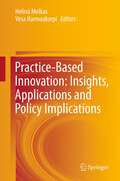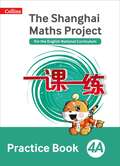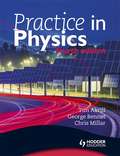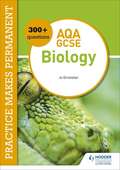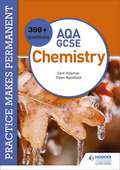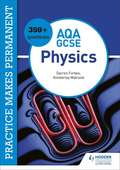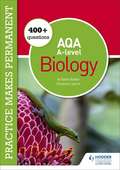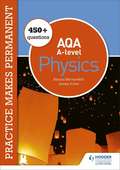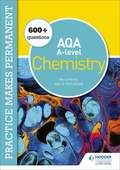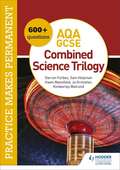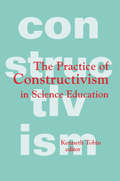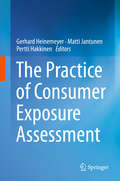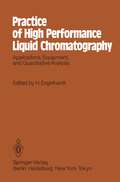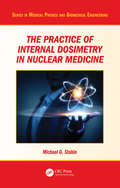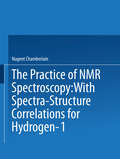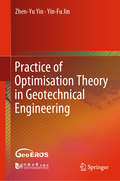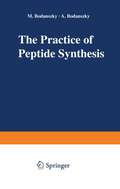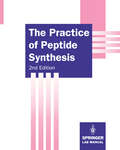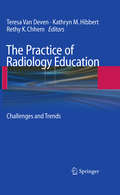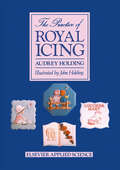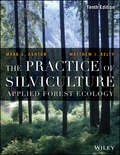- Table View
- List View
Practice-Based Innovation: Insights, Applications and Policy Implications
by Helinä Melkas and Vesa HarmaakorpiThe book describes and analyses the new environment for innovation, it does this with an emphasis on yet uncharted regions within the field of practice-based innovation, coming up with guidelines for innovation policy measures needed in order to realise this. While it focuses on these policies it also takes into account multi-actor innovation processes, user-driven innovation, "related variety" and many other aspects; aspects such as, just to name a few: communicating creative processes and distributing practice-based innovation; then there is creativity itself, encompassing new fields of knowledge and expertise. The authors go on to describe value networks, showing how to make practice-based innovations, explaining innovation diffusion and absorptive capacity. The book presents new insights as well as the latest research related to the frequently used term "innovation". Definitions are put forward, giving, by way of examples, a detailed description of concepts we draw upon when using these. Innovation as a concept is constantly being subdivided into increasingly finer distinctions, which, in turn, determine the discourse. The book takes a close look at these, further taking into account the challenges as well as the opportunities inherent in developing practice-based innovation procedures and policies of global importance, never losing sight of advancing long-term effectiveness.
Practice Book 4a: (PDF) (The Shanghai Maths Project Series)
by Paul Broadbent Professor Lianghuo FanThe Shanghai Maths Project is based on the maths programme delivered in Shanghai. This authentic resource will provide complete coverage of the curriculum for years 1-11 plus varied practice of key concepts and summative assessments for each year. This second edition of The Shanghai Maths Project is an authentic Shanghai resource adapted for the English curriculum. • 2 workbooks per year • Units of practice linked to the teaching in the Teacher’s Guides • End of unit tests, end of year test • Learner books support pupils with key maths facts and vocabulary • Full coverage of UK curriculum objectives
Practice in Physics (PDF)
by Tim Akrill George Bennet Chris MillarThe highly successful Practice in Physics has been completely revised and updated in this fourth edition to satisfy the latest examination specifications. The questions have been grouped into familiar topics. Summary sections of key equations and concepts to be covered are included at the start of each chapter. These are followed by a variety of progressive questions designed to lead the students from the most basic application of each new idea through to a full understanding of the concepts involved.
Practice makes permanent: 300+ questions for AQA GCSE Biology
by Jo OrmisherPractise and prepare for AQA A-level Biology with hundreds of topic-based questions and one complete set of exam practice papers designed to strengthen knowledge and prepare students for the exams.This extensive practice book raises students' performance by providing 'shed loads of practice', following the 'SLOP' learning approach that's recommended by teachers.- Consolidate knowledge and understanding with practice questions for every topic and type of question, including multiple-choice, multi-step calculations and extended response questions.- Develop the mathematical, literacy and practical skills required for the exams; each question indicates in the margin which skills are being tested.- Confidently approach the exam having completed one set of exam-style practice papers that replicate the types, wording and structure of the questions students will face.- Identify topics and skills for revision, using the page references in the margin to refer back to the specification and accompanying Hodder Education Student Books for remediation.- Easily check answers with fully worked solutions and mark schemes provided in the book.
Practice makes permanent: 350+ questions for AQA GCSE Chemistry
by Owen Mansfield Sam HolymanPractise and prepare for AQA GCSE Chemistry with hundreds of topic-based questions and one complete set of exam practice papers designed to strengthen knowledge and prepare students for the exams.This extensive practice book raises students' performance by providing 'shed loads of practice', following the 'SLOP' learning approach that's recommended by teachers.- Consolidate knowledge and understanding with practice questions for every topic and type of question, including multiple-choice, multi-step calculations and extended response questions.- Develop the mathematical, literacy and practical skills required for the exams; each question indicates in the margin which skills are being tested.- Confidently approach the exam having completed one set of exam-style practice papers that replicate the types, wording and structure of the questions students will face.- Identify topics and skills for revision, using the page references in the margin to refer back to the specification and accompanying Hodder Education Student Books for remediation.- Easily check answers with fully worked solutions and mark schemes provided in the book.
Practice makes permanent: 350+ questions for AQA GCSE Physics
by Kimberley Walrond Darren ForbesPractise and prepare for AQA GCSE Physics with hundreds of topic-based questions and one complete set of exam practice papers designed to strengthen knowledge and prepare students for the exams.This extensive practice book raises students' performance by providing 'shed loads of practice', following the 'SLOP' learning approach that's recommended by teachers.- Consolidate knowledge and understanding with practice questions for every topic and type of question, including multiple-choice, multi-step calculations and extended response questions.- Develop the mathematical, literacy and practical skills required for the exams; each question indicates in the margin which skills are being tested.- Confidently approach the exam having completed one set of exam-style practice papers that replicate the types, wording and structure of the questions students will face.- Identify topics and skills for revision, using the page references in the margin to refer back to the specification and accompanying Hodder Education Student Books for remediation.- Easily check answers with fully worked solutions and mark schemes provided in the book.
Practice makes permanent: 400+ questions for AQA A-level Biology
by Pauline Lowrie Ariadne BakerPractise and prepare for AQA A-level Biology with hundreds of topic-based questions and one complete set of exam practice papers designed to strengthen knowledge and prepare students for the exams.This extensive practice book raises students' performance by providing 'shed loads of practice', following the 'SLOP' learning approach that's recommended by teachers.- Consolidate knowledge and understanding with practice questions for every topic and type of question, including multiple-choice, multi-step calculations and extended response questions.- Develop the mathematical, literacy and practical skills required for the exams; each question indicates in the margin which skills are being tested.- Confidently approach the exam having completed one set of exam-style practice papers that replicate the types, wording and structure of the questions students will face.- Identify topics and skills for revision, using the page references in the margin to refer back to the specification and accompanying Hodder Education Student Books for remediation.- Easily check answers with fully worked solutions and mark schemes provided in the book.
Practice makes permanent: 450+ questions for AQA A-level Physics
by Alessio Bernardelli James IrvinePractise and prepare for AQA A-level Physics with hundreds of topic-based questions and one complete set of exam practice papers designed to strengthen knowledge and prepare students for the exams.This extensive practice book raises students' performance by providing 'shed loads of practice', following the 'SLOP' learning approach that's recommended by teachers.- Consolidate knowledge and understanding with practice questions for every topic and type of question, including multiple-choice, multi-step calculations and extended response questions.- Develop the mathematical, literacy and practical skills required for the exams; each question indicates in the margin which skills are being tested.- Confidently approach the exam having completed one set of exam-style practice papers that replicate the types, wording and structure of the questions students will face.- Identify topics and skills for revision, using the page references in the margin to refer back to the specification and accompanying Hodder Education Student Books for remediation.- Easily check answers with fully worked solutions and mark schemes provided in the book.
Practice makes permanent: 600+ questions for AQA A-level Chemistry
by Nora Henry Alyn G. McFarlandPractise and prepare for AQA A-level Chemistry with hundreds of topic-based questions and one complete set of exam practice papers designed to strengthen knowledge and prepare students for the exams.This extensive practice book raises students' performance by providing 'shed loads of practice', following the 'SLOP' learning approach that's recommended by teachers.- Consolidate knowledge and understanding with practice questions for every topic and type of question, including multiple-choice, multi-step calculations and extended response questions.- Develop the mathematical, literacy and practical skills required for the exams; each question indicates in the margin which skills are being tested.- Confidently approach the exam having completed one set of exam-style practice papers that replicate the types, wording and structure of the questions students will face.- Identify topics and skills for revision, using the page references in the margin to refer back to the specification and accompanying Hodder Education Student Books for remediation.- Easily check answers with fully worked solutions and mark schemes provided in the book.
Practice makes permanent: 600+ questions for AQA GCSE Combined Science Trilogy
by Jo Ormisher Kimberley Walrond Darren Forbes Sam Holyman Owen MansfieldPractise and prepare for AQA GCSE Combined Science with hundreds of topic-based questions and one complete set of exam practice papers designed to strengthen knowledge and prepare students for the exams.This extensive practice book raises students' performance by providing 'shed loads of practice', following the 'SLOP' learning approach that's recommended by teachers.- Consolidate knowledge and understanding with practice questions for every topic and type of question, including multiple-choice, multi-step calculations and extended response questions.- Develop the mathematical, literacy and practical skills required for the exams; each question indicates in the margin which skills are being tested.- Confidently approach the exam having completed one set of exam-style practice papers that replicate the types, wording and structure of the questions students will face.- Identify topics and skills for revision, using the page references in the margin to refer back to the specification and accompanying Hodder Education Student Books for remediation.- Easily check answers with fully worked solutions and mark schemes provided in the book.
The Practice of Constructivism in Science Education
by Kenneth TobinThis volume provides a needed elaboration of theories and potential applications of constructivism in science education. Although the term "constructivism" is used widely, there has been a dearth of materials to guide science educators concerning the potential of constructivism to influence what is done in the field. In fact, there has been a tendency for constructivism to be viewed as a method that can be used in a classroom. This view tends to diminish the power of constructivism as a way of thinking about education, and in particular, about science education. The chapters in this book address the need to document the theoretical roots of constructivism and to describe how practitioners have applied constructivist oriented beliefs in the practice of K-12 teaching of science and mathematics, as well as teacher education. Not only does this book contain different theoretical perspectives on constructivism, but it also features a chapter that critiques constructivism as an epistemology. Specific topics covered include: * cooperative learning, * the negotiation of meaning, * problem centered learning, * social construction of knowledge, * science in culturally diverse settings, * curriculum planning and implementation, and * instructional technology. Issues associated with the preparation and enhancement of science teachers and the reform of science education are also explored.
The Practice of Constructivism in Science Education
by Kenneth G. TobinThis volume provides a needed elaboration of theories and potential applications of constructivism in science education. Although the term "constructivism" is used widely, there has been a dearth of materials to guide science educators concerning the potential of constructivism to influence what is done in the field. In fact, there has been a tendency for constructivism to be viewed as a method that can be used in a classroom. This view tends to diminish the power of constructivism as a way of thinking about education, and in particular, about science education. The chapters in this book address the need to document the theoretical roots of constructivism and to describe how practitioners have applied constructivist oriented beliefs in the practice of K-12 teaching of science and mathematics, as well as teacher education. Not only does this book contain different theoretical perspectives on constructivism, but it also features a chapter that critiques constructivism as an epistemology. Specific topics covered include: * cooperative learning, * the negotiation of meaning, * problem centered learning, * social construction of knowledge, * science in culturally diverse settings, * curriculum planning and implementation, and * instructional technology. Issues associated with the preparation and enhancement of science teachers and the reform of science education are also explored.
The Practice of Consumer Exposure Assessment
by Gerhard Heinemeyer Matti Jantunen Pertti HakkinenThis book closes a current gap by providing the scientific basis for consumer exposure assessment in the context of regulatory risk assessment. Risk is defined as the likelihood of an event occurring and the severity of its effects. The margin between the dose that leads to toxic effects and the actual dose of a chemical is identified by estimating population exposure. The objective of this book is to provide an introduction into the scientific principles of consumer exposure assessment, and to describe the methods used to estimate doses of chemicals, the statistics applied and computer tools needed. This is presented through the backgrounds of the special fields in exposure analysis, such as exposure via food and by the use of consumer products, toys, clothing and other items. As a general concept, human exposure is also understood to include exposure via the environment and from the work setting. In this context, the specific features of consumer exposure are pointed out and put into the context of regulation, in particular food safety, chemicals safety (REACh) and consumer product safety. The book is structured into three parts: The first part deals with the general concepts of consumer exposure as part of the overall risk analysis framework of risk characterization, risk assessment and risk communication. It describes the three basic features of exposure assessment (i) the exposure scenario (ii) the exposure model and (iii) the exposure parameters, addressing external and internal exposure. Also, the statistical presentation of data to characterize populations, in connection with variability, uncertainty and quality of information and the presentation of exposure evaluation results is described. The second part deals with the specific issues of exposure assessment, exposure via food consumption, exposure from use of consumer products, household products, toys, cosmetic products, textiles, pesticides and others. This part also covers methods for acquisition of data for exposure estimations, including the relevant information from regulations needed to perform an accurate exposure assessment. The third part portrays a prospect for further needs in the development and improvement of consumer exposure assessment, as well as international activities and descriptions of the work of institutions that are involved in exposure assessment on the regulatory and scientific level. And conversely, it creates the rationale for the exposure assessment details necessary to satisfy regulatory needs such as derivation of upper limits and risk management issues.
Practice of High Performance Liquid Chromatography: Applications, Equipment and Quantitative Analysis (Chemical Laboratory Practice)
by K. Aitzetmüller J. Asshauer P. R. Brown H. Colin T. Crispin J. P. Crombeen T. Daldrup H. Engelhardt G. Guiochon I. Halasz A. P. Halfpenny H. Hulpke B. L. Karger J. C. Kraak H. J. Kuss M. Martin P. Michalke H. J. Möckel B. A. Persson S. Szathmary G. Tittel M. Uihlein H. Ullner H. Wagner A. Wehrli U. WerthmannDuring its short 20 year history High Performance Liquid Chro matography (HPLC) has won itself a firm place amongst the instrumental methods of analysis. HPLC has caused a revolution in biological and pharmaceutical chemistry. Approximately two thirds of the publications on HPLC are concerned with problems from this area of life science. Biotechnology, where it is necessary to isolate substances from complicated mixtures, is likely to give further impetus to the dissemination of modern liquid chromatog raphy in columns, particularly on the preparative scale. This book presents, by means of examples, the application of HPLC to various fields, as well as fundamental discussions of chromatographic methods. The quality of the analytical result is decisively dependent on the qualities of the equipment employed (by Colin, Guiochon, and Martin). Especially the demands are discussed that are placed on the components of the instrument including those for data acquisition and processing. The section on "quantitative analy sis" (by ABhauer, Ullner) covers besides the principles also the problems of ensuring the quality of the data in detail. The basic problems arising by enlarging the sample size to preparative di mensions and the requirements put on the aparatus are discussed in the section on "preparative applications" (by Wehrli).
The Practice of Internal Dosimetry in Nuclear Medicine (Series in Medical Physics and Biomedical Engineering)
by Michael G. StabinWritten by one of the world's leading experts in the field of nuclear medicine dosimetry, this text describes in detail the use of internal dose calculations in the practice of nuclear medicine. While radiation therapy with external sources of radiation always employs calculations of dose to optimize therapy for each patient, this is not routinely conducted in nuclear medicine therapy. As the trend towards an increasing role of dosimetry in therapy planning increases, this book reviews the available methods and technologies available to make this a more common practice. The book begins by covering the mathematical fundamentals of internal dose calculations, and uses sample calculations to demonstrate key principles. The book then moves forward to describe anthropomorphic models, dosimetric models, and types and uses of diagnostic and therapeutic radiopharmaceuticals. The depth of coverage makes it useful reference and guide for researchers performing dose calculations and for physicians considering incorporating dose calculations into the treatment of their cancer patients.
The Practice of Internal Dosimetry in Nuclear Medicine (Series in Medical Physics and Biomedical Engineering)
by Michael G. StabinWritten by one of the world's leading experts in the field of nuclear medicine dosimetry, this text describes in detail the use of internal dose calculations in the practice of nuclear medicine. While radiation therapy with external sources of radiation always employs calculations of dose to optimize therapy for each patient, this is not routinely conducted in nuclear medicine therapy. As the trend towards an increasing role of dosimetry in therapy planning increases, this book reviews the available methods and technologies available to make this a more common practice. The book begins by covering the mathematical fundamentals of internal dose calculations, and uses sample calculations to demonstrate key principles. The book then moves forward to describe anthropomorphic models, dosimetric models, and types and uses of diagnostic and therapeutic radiopharmaceuticals. The depth of coverage makes it useful reference and guide for researchers performing dose calculations and for physicians considering incorporating dose calculations into the treatment of their cancer patients.
Practice of Intramedullary Locked Nails: New Developments in Techniques and Applications
by Volker Alt Kwok-Sui Leung Ivan Kempf H.J.T.M. Haarman Gilbert Taglang Hartmut Seidel Reinhard SchnettlerThe third volume of the "Practice of Intramedullary Locked Nails" places a special focus on recent advancements in understanding the biology of fracture healing of long bones, the emerging technologies that further enhance the minimally invasive nature of closed treatment of fractures, and the availability of various surgical techniques in intramedullary fixation. The application of new technology in prevention of infection and application of the intramedullary fixation of fractures in pediatric and adolescent patients are also described. The contributors to this volume are from different well-known trauma centers and are pioneer surgeons in the development and practice of intramedullary locked nails.
The Practice of NMR Spectroscopy: with Spectra-Structure Correlations for Hydrogen-1
by Nugent ChamberlainI. GENERAL When a sample containing hydrogen is placed in the Although it is assumed that the reader has been exposed static magnetic field, each hydrogen nucleus will precess to the elementary theory of NMR and to the operation at a frequency determined by the magnetic field it of an NMR spectrometer, a brief review of some of the actually experiences. This field, in turn, is determined by basic concepts and definitions will indicate the point of the electronic, and therefore the chemical, environment view used in this book and clarify some of the defini of the nucleus. Thus the variety of chemical environ tions. The discussion is confined to the hydrogen-l iso ments that exist in a molecule will produce a spectrum tope because this is by far the most generally used and, of precession frequencies that will indicate the chemical consequently, far more data are available for it than for nature of the various parts of the molecule. The remain any other isotope. This wealth of data, in turn, leads to ing problem is to observe this spectrum of frequencies. the most accurate and comprehensive set of spectra There are two general methods of observing the structure correlations. spectrum.
Practice of Optimisation Theory in Geotechnical Engineering
by Zhen-Yu Yin Yin-Fu JinThis book presents the development of an optimization platform for geotechnical engineering, which is one of the key components in smart geotechnics. The book discusses the fundamentals of the optimization algorithm with constitutive models of soils. Helping readers easily understand the optimization algorithm applied in geotechnical engineering, this book first introduces the methodology of the optimization-based parameter identification, and then elaborates the principle of three newly developed efficient optimization algorithms, followed by the ideas of a variety of laboratory tests and formulations of constitutive models. Moving on to the application of optimization methods in geotechnical engineering, this book presents an optimization-based parameter identification platform with a practical and concise interface based on the above theories. The book is intended for undergraduate and graduate-level teaching in soil mechanics and geotechnical engineering and other related engineering specialties. It is also of use to industry practitioners, due to the inclusion of real-world applications, opening the door to advanced courses on both modeling and algorithm development within the industrial engineering and operations research fields.
The Practice of Peptide Synthesis (Reactivity and Structure: Concepts in Organic Chemistry #21)
by Miklos Bodanszky Agnes BodanszkyDuring the years 1980-81, as guests of the Deutsches Woll forschungsinstitut in Aachen, Germany, we were working on a small book entitled, "Principles of Peptide Synthesis". In the library of the Institute we noted that the volumes of Houben-Weyl's Handbuch der Organischen Chemie dealing with peptide synthesis were so much in use that they were ready to fall apart because the researchers of the Institute consulted them with amazing regularity. They were looking for references, but even more for experimental details which could be adapted to the particular problem they happened to face. In planning a new synthetic endeavor they tried to lean on the experience of others in analogous situations. This suggested to us that a smaller and hence more tractable book may be needed, a volume which can be kept on or near the bench to make examples of funda mental methods readily available in the laboratory. Such a collection could save numerous short trips to the library, a point particularly important where a library well equipped with the sources of the literature of peptide synthesis is not near at hand. Also, we thought that the envisaged book may be welcome by those who are more versed in English than in German. To our best knowledge no similar publi cation is available.
The Practice of Peptide Synthesis (Springer Lab Manuals)
by Miklos Bodanszky Agnes BodanszkyDuring the years 1980-81, as guests of the Deutsches Wollforschungsinstitut in Aachen, Germany, we were working on a small book entitled, "Principles of Peptide Synthesis". In the library of the Institute we noted that the volumes of Houben-Weyl's Handbuch der Organischen Chemie dealing with peptide synthesis were so much in use that they were ready to fall apart because the researchers of the Institute consulted them with amazing regularity. They were looking for references, but even more for experimental details which could be adapted to the particular problem they happened to face. In planning a new synthetic endeavor they tried to lean on the experience of others in analogous situations. This suggested to us that a smaller and hence more tractable book may be needed, a volume which can be kept on or near the bench to make examples of fundamental methods readily available in the laboratory. Such a collection could save numerous short trips to the library, a point particularly important where a library well equipped with the sources of the literature of peptide synthesis is not near at hand. Also, we thought that the envisaged book may be welcome by those who are more versed in English than in German. To the best of our knowledge no similar publication is available.
The Practice of Radiology Education: Challenges and Trends
by Teresa Van Deven Kathryn M. Hibbert Rethy K. ChhemThe practice of radiology education: challenges and trends will provide truly helpful gu- ance for those of you involved in teaching and training in radiology. The goal of this book is ultimately to improve patient care. As a companion piece to the first book radiology education: the scholarship of teaching and learning, this book focuses on applying the concepts at a practical level that can be applied flexibly within educational programs for radiology residents and fellows in any medical imaging learning environment. This book focuses on the application of scholarship in terms of the “dissemination of useful, testable and reproducible information to others. ” It links educational theory with practice and for those of you who wish to explore educational practice further, a number of chapters s- gest additional readings and resources. The publication is timely and congruent with one of the most important twenty-first century trends in medical education: the move from amateurism to professionalism in teaching. In the past, medical schools and other health professions’ training institutions have been criticized for their resistance to the adoption of the science of medical edu- tion. Very few of us learned how to teach as medical students and most of us have our teaching responsibilities thrust on us with little preparation. The award of a basic medical degree was assumed to carry with it basic teaching expertise, unfortunately an unw- ranted assumption in some cases.
The Practice of Royal Icing
by A. HoldingWhen in 1 980 I wrote the foreword to The Art of Roya//cing I wished my friend Audrey Holding every success for her book; I was convinced that its appearance would fill a real gap in the literature then available by providing a comprehensive but simple and practicable guide to the techniques used in royal icing. Now. six years later. with The Art of Roya//cing sold widely throughout the world. I know that Audrey's second book on this subject is assured of success. In it she has developed many of the ideas presented in her first book. and she takes the cake-decorator through the stages of intricate techniques which would normally be regarded as beyond the competence of the amateur. With Audrey's guidance (and lots of patient practice!) we can all become experts. JUNE ELWOOD M. lnst. B. B. , M. e. FA(e. G) Cake Artistry Studio. Swinton, Manchester, UK v Preface My first book. The Art of Royal Icing * set out to explain the craft to those who had no previous knowledge of the subject. In this book. I hope to go one stage further and expand the ideas and techniques formulated in The Art of Royal Icing. especially in relation to runout figure piping. In order to avoid repetition. some basics have been omitted. enabling other areas to be dealt with in greater detail.
The Practice of Silviculture: Applied Forest Ecology
by Mark S. Ashton Matthew J. KeltyThe most up-to-date, comprehensive resource on silviculture that covers the range of topics and issues facing today’s foresters and resource professionals The tenth edition of the classic work, The Practice of Silviculture: Applied Forest Ecology, includes the most current information and the results of research on the many issues that are relevant to forests and forestry. The text covers such timely topics as biofuels and intensive timber production, ecosystem and landscape scale management of public lands, ecosystem services, surface drinking water supplies, urban and community greenspace, forest carbon, fire and climate, and much more. In recent years, silvicultural systems have become more sophisticated and complex in application, particularly with a focus on multi-aged silviculture. There have been paradigm shifts toward managing for more complex structures and age-classes for integrated and complementary values including wildlife, water and open space recreation. Extensively revised and updated, this new edition covers a wide range of topics and challenges relevant to the forester or resource professional today. This full-color text offers the most expansive book on silviculture and: Includes a revised and expanded text with clear language and explanations Covers the many cutting-edge resource issues that are relevant to forests and forestry Contains boxes within each chapter to provide greater detail on particular silvicultural treatments and examples of their use Features a completely updated bibliography plus new photographs, tables and figures The Practice of Silviculture: Applied Forest Ecology, Tenth Edition is an invaluable resource for students and professionals in forestry and natural resource management.
The Practice of Silviculture: Applied Forest Ecology
by Mark S. Ashton Matthew J. KeltyThe most up-to-date, comprehensive resource on silviculture that covers the range of topics and issues facing today’s foresters and resource professionals The tenth edition of the classic work, The Practice of Silviculture: Applied Forest Ecology, includes the most current information and the results of research on the many issues that are relevant to forests and forestry. The text covers such timely topics as biofuels and intensive timber production, ecosystem and landscape scale management of public lands, ecosystem services, surface drinking water supplies, urban and community greenspace, forest carbon, fire and climate, and much more. In recent years, silvicultural systems have become more sophisticated and complex in application, particularly with a focus on multi-aged silviculture. There have been paradigm shifts toward managing for more complex structures and age-classes for integrated and complementary values including wildlife, water and open space recreation. Extensively revised and updated, this new edition covers a wide range of topics and challenges relevant to the forester or resource professional today. This full-color text offers the most expansive book on silviculture and: Includes a revised and expanded text with clear language and explanations Covers the many cutting-edge resource issues that are relevant to forests and forestry Contains boxes within each chapter to provide greater detail on particular silvicultural treatments and examples of their use Features a completely updated bibliography plus new photographs, tables and figures The Practice of Silviculture: Applied Forest Ecology, Tenth Edition is an invaluable resource for students and professionals in forestry and natural resource management.
